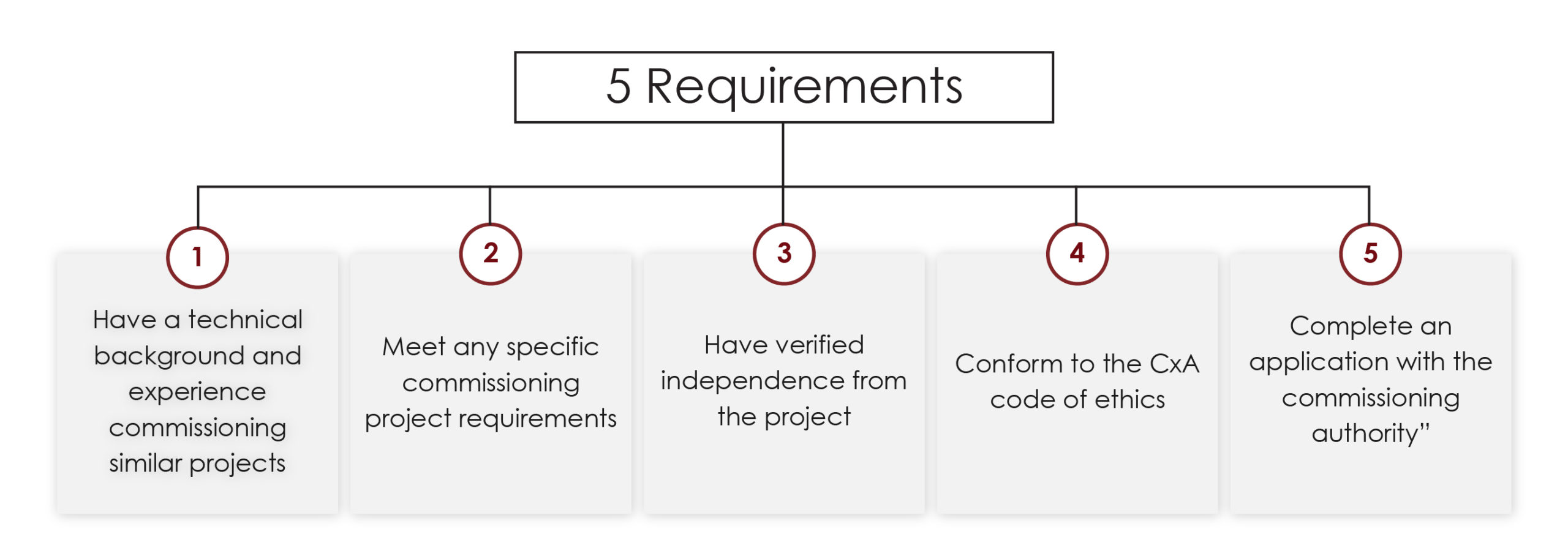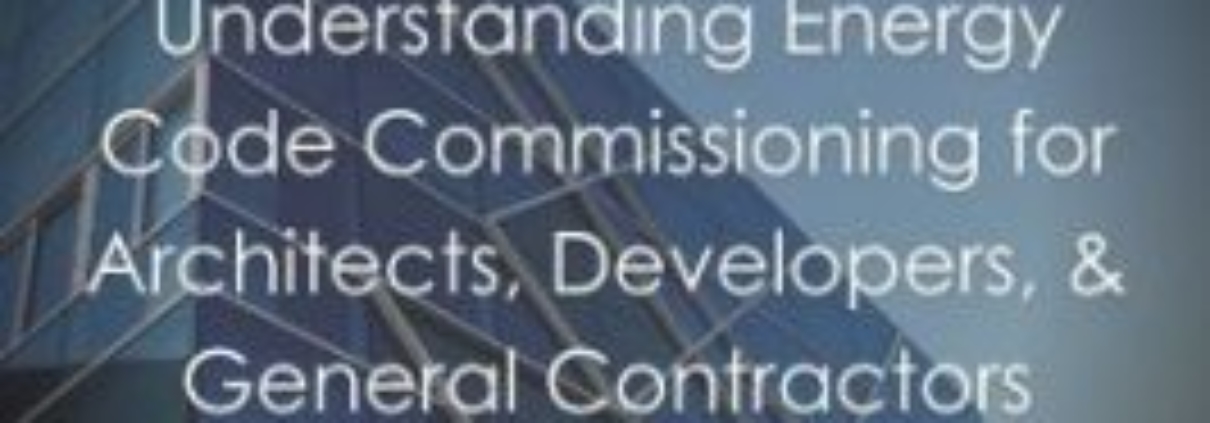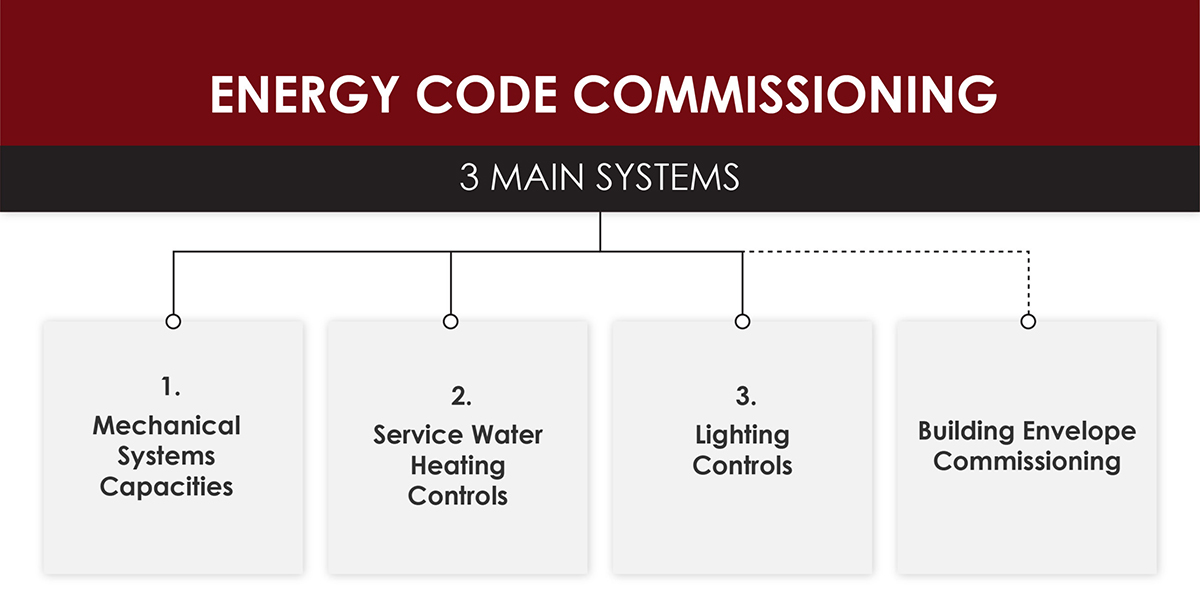The Owners Guide to Energy Code Commissioning: A Primer for Architects, Developers & General Contractors
Architects, developers, and general contractors are expected to know how all kinds of building codes apply to their projects. Energy codes are no different. Just like other building codes, the energy code is different from state to state and may change over time. In other words, the way you built or designed a building to meet energy code last year may not work this year.
What Are Energy Codes?
Energy codes are just one specific type of code that falls under the larger umbrella of building codes. Energy codes set the standard for the minimum requirements of materials, processes, and efficiencies used in the construction of buildings in relation to building systems. Energy codes look at many different aspects of construction and more elements are added every year. The energy code governs many parts of a building that consumes or impacts the consumption and efficiency of energy. These aspects are often broken down into the building envelope, mechanical systems, and lighting and power categories.
Within the building envelope, the requirements in energy code address the properties and assembly of the building’s thermal envelope (a technical-sounding term that covers all materials separating the conditioned from unconditioned spaces such as exterior wall assemblies). Insulation values as well as standards of installation, air sealing, window performance values, and amount of glass are given in the energy code.
Mechanical requirements include heating and cooling system types, efficiencies, controls, spot or source ventilation such as bathroom exhaust, kitchen exhaust, and whole-building ventilation (or the introduction of outside air). Energy codes will also dictate how mechanical systems must be controlled under different scenarios. Mechanical systems also include the use of domestic water heating.
Electrical energy code requirements dictate lighting needs for both inside and outside the building, lighting fixtures, and lamps, as well as incorporating lighting control needs based on proximity and availability of daylight, and the associated occupancies of each space. These lighting needs will vary by space type, occupancy, and location.
Adoption & Enforcement of Energy Codes
So is there a single national energy code that everyone follows throughout the country? No, that would make things too simple and not necessarily serve the needs of individual areas. Energy code adoption is determined at the state and local levels. Although these local levels of government determine what energy code to follow, they are typically based on established codes and standards. The two energy codes that are most often adopted as the standard for a given jurisdiction are the International Energy Conservation Code (IECC) and ASHRAE Standard 90.1 Energy Standard for Buildings Except for Low-Rise Residential Buildings. To make things a little more complicated, the IECC references ASHRAE 90.1 as a path to compliance. Both of these are regularly updated generally on a three-year cycle, and states adopt these updated versions for their energy codes. At a more granular level, cities and municipalities can change or amend these energy codes by making the requirements more stringent within their jurisdiction. The interpretation of the amendments as well as the documentation of compliance all occurs at the city or county level.
State Regulation
Some states require much stricter energy code requirements than others. Congress can pass laws that set a baseline requirement for energy efficiency, but it is then up to each individual state to adopt the code and more importantly to enforce the code. California’s Title 24-Part 6 code is the California-specific energy and building codes. Title 24-Part 6 requires much greater levels of energy efficiency than other states throughout the country. Some of the requirements in Title 24 focus specifically on saving energy during peak power times of the year, such as the requirement that all buildings over 1,000 square feet must have demand responsive controls
Local Regulation
In addition to the state’s adoption of energy codes, the local-level governments and Authorities Having Jurisdiction (AHJ) can choose to amend or add to these codes. San Antonio, Texas, for example, was the first city in Texas to adopt the 2018 I-Codes on June 21, 2018. San Antonio, along with several other jurisdictions, now requires a Mechanical, Electrical Controls, and Plumbing Commissioning Plan at the time of permit submittal, and prior to Certificate of Occupancy (COO) issuance, a Preliminary Commissioning Report (Pre-Final) must be submitted, along with several other 2018 IECC Submittal Requirements for commercial projects. By requiring a Commissioning Agent (CxA) to be identified at the beginning of the design and construction process, San Antonio ensures that the full value of commissioning can be realized. By having a CxA involved with the project at the design stage, a lot of errors can be avoided further along in the process. The CxA keeps the project within the guidelines of the IECC and can pinpoint issues well before they become expensive change orders. Many other jurisdictions don’t require a CxA to be brought in until the project is halfway complete. At this point, changes that must be made to ensure compliance become a lot more expensive. Having the CxA involved from the beginning maximizes the value of commissioning for the general contractor, the owner, and the entire build team.
Denver, Colorado, is another city that has chosen to adopt the 2018 IECC as a base for their energy code. Local jurisdictions also have the power to amend and build on the energy codes that they adopt. Denver adopted the 2018 IECC on August 1, 2020, but they didn’t just leave everyone to figure out the changes on their own. The City of Denver understands that code updates can be complicated and confusing. By providing virtual training that discussed how the energy code changes would impact contractors, architects, engineers, and inspectors, conformance to the code will be easier to achieve making the commissioning process more efficient and providing more value to all involved parties.
The 2021 IECC aims to improve the energy efficiency of all new construction by requiring residential and commercial buildings to reduce their energy consumption by an estimated 10% overall, which is several times that of past code cycles. The ICC’s 2021 international energy conservation code will undoubtedly be the most efficient building code to date. To stay up to date on the energy codes updates, subscribe to our mailing list (sign-up form in footer). For specific questions on the 2021 IECC impact for any particular building type, contact Jordan & Skala Engineers Sustainability Services division.
One of the biggest updates to the Denver energy code involved classifying any multifamily building under the commercial provisions of the energy code. Previously some residential buildings were classified under the residential energy code as long as they were under three stories in height. This was a major departure from the national standard of energy code classifications for residential buildings. Denver also made revisions to the commissioning requirements of mechanical and electrical systems as well as adding requirements for the building envelope.
These cities may hold buildings to higher energy code standards than the rest of the cities in Texas or Colorado, respectively. It’s important that architects, engineers, developers, and general contractors are familiar with the local energy codes for the cities they are building in, with a knowledgeable commissioning team to oversee all systems.
Who is Allowed to Perform Energy Code Commissioning?
Commissioning ensures that a project meets the Owner’s Project Requirements (OPR) and Basis of Design (BOD) specifications. Commissioning is an essential part of making sure that the HVAC, domestic hot water systems, and lighting systems operate the way they were intended and that all the smart controls operate appropriately, but who is the person that actually does the commissioning?
The person who ensures that the commissioning is carried out properly is the Commissioning Agent (CxA). Not anyone can be a CxA and some jurisdictions have more restrictions than others. To determine if the AHJ (Authority Having Jurisdiction) has specific requirements for a CxA, consult the local building code office where the project is located. In general, the CxA should meet five basic requirements:
- Have a technical background and experience commissioning similar projects
- Meet any specific commissioning project requirements
- Have verified independence from the project
- Conform to the CxA code of ethics
- Complete an application with the commissioning authority
Of all of these requirements, arguably the most important is the CxA’s independence from the project. Using a third-party CxA is the best way to ensure that the CxA has no conflicts of interest. An independent CxA can evaluate the design and the construction of the building and coordinate with the entire team to make sure that the building will comply with the energy code. The CxA needs to be free from conflicts of interest with the engineer of record, the design team, the general contractor, and any subcontractors. The CxA must also be free of any financial interest in the project. Being completely independent is the only way to ensure the CxA can do his or her job without bias.
When is Commissioning Required?
Commissioning is designed to optimize the built environment for energy efficiency which leads to better building performance and reduced energy costs. Energy code commissioning is not only a requirement to receive a certificate of occupancy for many projects but provides a lot of value to the design team, the construction team, and the owner as well. Energy Code commissioning helps to verify that systems are operating as designed which optimizes the owner’s operating costs and ensures that the vision of the design team has been properly realized. Commissioning also helps to reduce the frequency and cost of change orders and other disruptions during the construction process. With commissioning, a building will perform better throughout its lifecycle, but the energy codes make certain exceptions to what must be commissioned. As of the 2012 IECC and ASHRAE 90.1-2010, the energy code has required building commissioning as part of the energy code for buildings that meet certain criteria. Whether or not a building will require energy code commissioning depends on what standard is being followed.
The IECC requires commissioning for certain mechanical systems such as systems that provide over 40 tons of cooling for the building and/or space and water heating systems that provide more than 600 MBH of heat. ASHRAE 90.1 doesn’t look at the total system size, however. Commissioning is required under ASHRAE 90.1 if the building is larger than 50,000 square feet, regardless of the mechanical system’s heating and cooling capacities. The energy codes do not just require commissioning for new construction but also for any tenant build-outs that add or change the lighting or mechanical systems within an existing space. Anything added to or altered in an existing construction must comply with the current energy code.

Mechanical & Plumbing Systems Commissioning
In the IECC, HVAC systems commissioning is required when there is over 40 tons of cooling and/or 600,000 Btu/hr of space and water heating. Testing and balancing must be performed on the mechanical system to make sure all equipment is operating as designed. Air and water flow rates are measured and adjusted to ensure that they all fall within the tolerances of the design. In addition to ensuring flowrates are correct, mechanical systems also undergo functional performance testing to measure whether or not they perform as designed for all expected scenarios or operation.
For compliance with energy codes, one of the most important aspects of mechanical systems are the controls. Energy efficiency is maximized when equipment only comes on when needed and is operating in the most energy-efficient mode for the conditions and how the space is being utilized at a specific moment. Air and water-side economizers are used to save energy on mechanical systems, but they are only useful if they work when they are supposed to. Economizer controls are calibrated and adjusted as part of commissioning. The sequence of operations is also checked and proper equipment operation is verified.
Modern lighting systems can be extremely complicated. Lighting controls function testing is required due to the complexity of these new building controls. The main idea behind modern lighting controls is that the lighting load varies throughout time. Lighting loads need to be able to change in response to the time of day, time of year, and in response to how the space is being used. Occupant sensors, time switch, and daylight responsive controls are all checked during commissioning.
Depending on which energy code the project requires will greatly influence how the lighting is designed for the space. For example, the lighting load in an indoor enclosed space must be able to be uniformly reduced by 50% according to the IECC. The energy code also mentions how the lighting controls dim the lights as more daylight is entering the space. ASHRAE 90.1 allows the lights to be dimmed in a multistep fashion while IECC requires that the lights dim continuously. Knowing these subtle differences can be critical to finishing a project efficiently and within budget.
Know the Code
Energy codes don’t have to be a hindrance, in fact, they are the only codes that offer a return on investment! Understanding your local energy code and knowing how it applies to your building can be the difference between a successful job and one with a lot of callbacks and change orders. Jordan & Skala Engineers takes the guesswork out by staying up to date on upcoming code changes to keep your business a step ahead of the competition and help make sure you have more successful projects.
Download Guide
For a more in-depth PDF, which covers the Energy Code Commissioning systems, what they entail, and the requirements a Commissioning Agent must fulfill to make a project successful, please submit your information below. You’ll be taken to a new tab where you have access to download the complete PDF.


Leave a Reply
Want to join the discussion?Feel free to contribute!